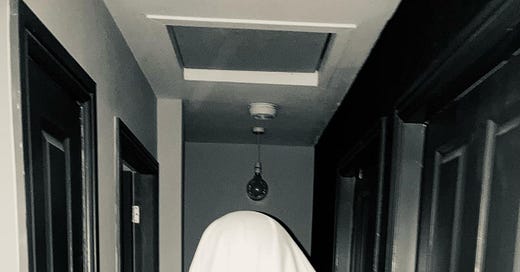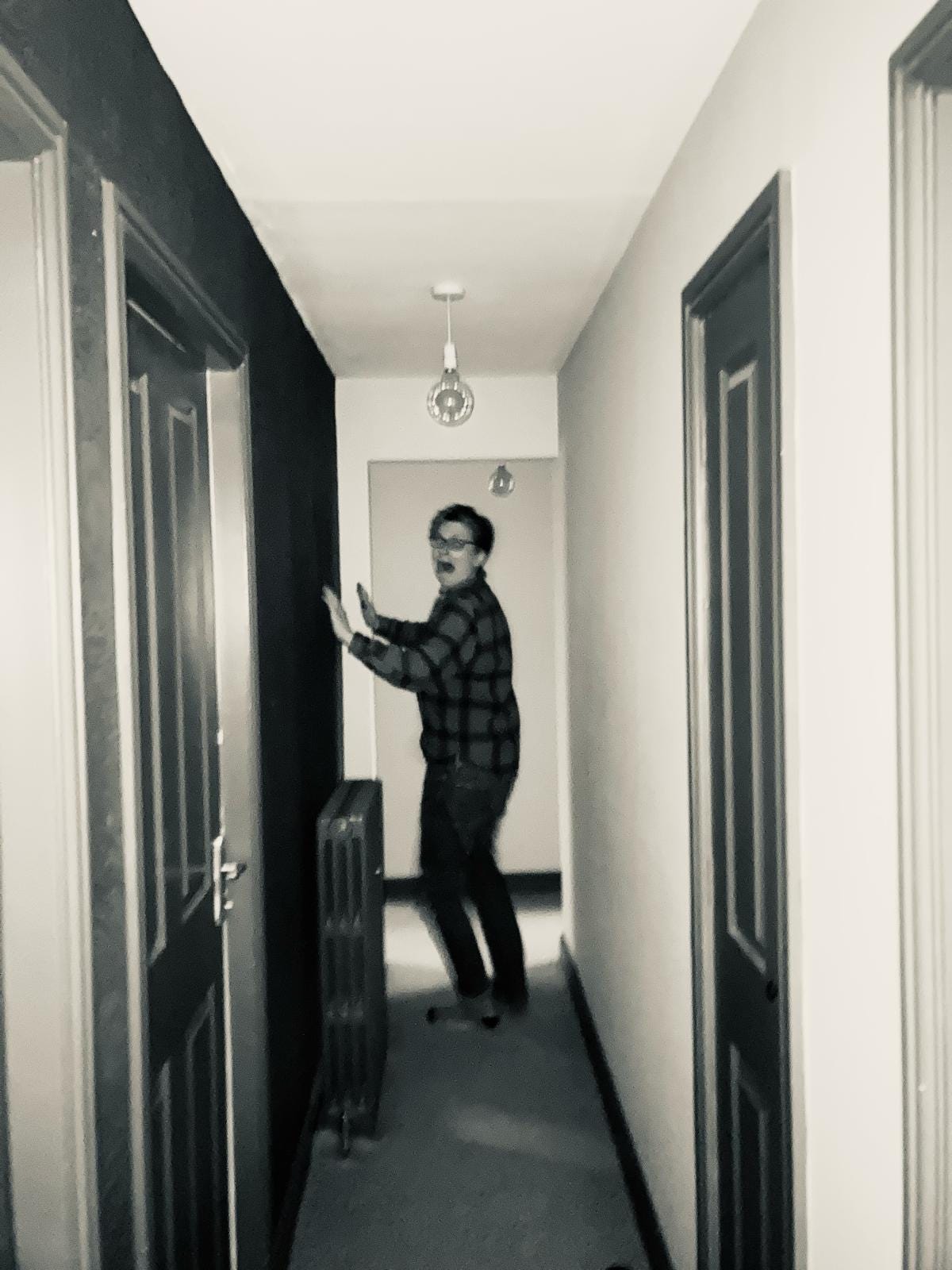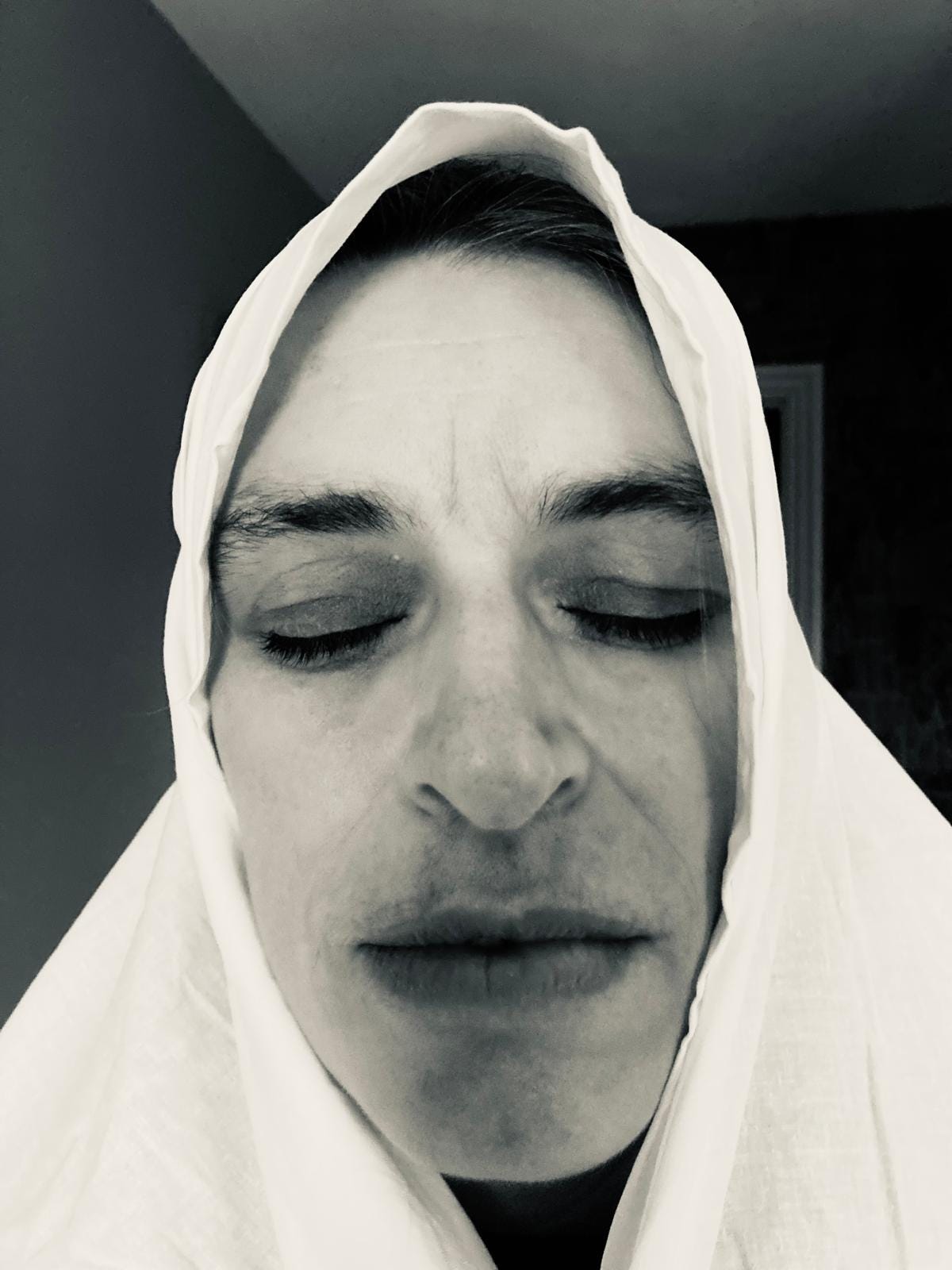Halloween is almost upon us! And from Monday 28th-Friday 1st November, I’ll be working with Anthony Capildeo to deliver “Haunted Landscapes” - an online Arvon writing week. To mark the occasion, I’m releasing this ghostly article - which was first published several months ago to our paying subscribers only. It’s now available to everyone for free - instead, I’ll send our paying subscribers some haunted exercises and writing prompts. Without further ado ..
After I finished my last collection, I considered I wanted to spend the next three years obsessing about. It should be something that fascinated me, something rich in poetic and metaphorical potential, which would allow me to research and procrastinate to my heart’s content. I came up with three options – caves, ruins, and ghosts.
In the end, ghosts got my vote. Every house that I lived in as a child was haunted, and it seemed, every property we visited. It’s only in very recent years I’ve realised that not every childhood is coloured by floating lights in the attic and disembodied whispers.
There’s a common belief that poltergeist activity is associated with troubled teenage girls: we had plenty of them, and troubled boys too. Did we attract the bad spirits? Or did the creative and chaotic energy of our troubled minds manifest itself in the remote moving of objects, the unexplained noises and visions? And is poetry the right place to make sense of these experiences?
In our Catholic, working-class Burnley, belief in ghosts was not unusual – break into a good ghost story and people are almost certain to join in. It’s not so true in the secular, middle class world I now inhabit. Here, seeing ghosts marks you out as superstitious, uncultured – to be honest, a bit common.
But I’ve been told enough times in my life that my world view is mistaken or just plain mad – so a hierarchy of knowledge which dismisses millions of people’s accounts of their own lives as uncivilised nonsense is something I’m not just going to accept. Even more than that, I’m fascinated by the assumptions and processes which underpin of knowledge of the world. How do any of us know what we know?
The imperfect answer: because we perceive the world through our senses. And then, based on memory, assumption, convention and prediction, we translate sights, sounds, smells, tastes and touch into a working model of our internal and external states. It’s an inherently approximate, subjective and fluid process.
And that, to me, is stuff of magic. Not just the life-saving realisation that I could reject the truths I had been handed – no, it was not okay, it was not funny, I was not mad – but the beautiful universe of possibility which opens up light years of stars, layers of endless space and light. I love it. And for the past two years I’ve been happily exploring the ways in which ghost stories exemplify this – the shifting, partial, contingent nature of perception.
I’ve been contentedly listening to hundreds of ghost stories – including the hauntings within my extended family. My cousin, born after several years of documented poltergeist activity in her home – described the extreme fear of her childhood; how she used to brush her teeth with her back to the wall in case someone/thing “got her”; how, when she was left alone in the house as a small child, she’d lie screaming in a foetal position on the floor. Although my contact with my close family is very limited, I’ve heard how their ghostly experiences persisted into the present day.
Laythe et al (2020) suggested the experiences of repeatedly seeing ghosts might be usefully be described by the term “Haunted People Syndrome”. According to their 5-year research project, people who have multiple paranormal experiences are likely to have grown up in cultures marked by belief in the paranormal; to be experiencing stress or fear; to be highly sensitive to sensory changes; and to score highly on transliminality scales – that is, to have a thin mental boundary between their conscious and unconscious mind and their external context.
The concept of transliminality - "a hypothesized tendency for psychological material to cross thresholds into or out of consciousness" (Thalbourne and Houran, 2000) - was anticipated by Freud, James and other early twentieth century theorists of mind and consciousness, but the Transliminality Scale and other empirical measurements have only existed in recent decades. Through questions focussed on sensitivity, creativity, and mystical experiences, they try to provide an objective measurement of a person’s tendency to readily and easily cross the threshold between conscious and unconscious states. The artist, writer and musician Burning Salt, describes this experience:
As I drifted along the edge of consciousness, I suddenly found myself within a dark cave: a space I had never seen before, yet knew completely. I could taste the weight of salt air, feel the cave’s darkness on my skin. That was my song space, I thought as I came to. This was the only language I had at that time for what I had experienced. That was the place my songs came from …
On the other side of this breakthrough came a collapse. The following night, triggered by the sound of footsteps in the apartment above, I had a panic attack that lasted over 24 hours … I was later diagnosed with C-PTSD.
These two events – the vision and the attack – marked the beginning of a significant reckoning with deeply stored pain; and an even deeper beauty. Were they connected? I can’t say for certain… but I do know these spaces have danced closely with each other ever since. “ (2023)
This dance between creativity, mysticism, bodily differences and trauma began to draw me in … I thought about another friend, the musician and writer Sonya Moorhead, who is writing her eighties childhood through a retelling of the Ulster cycle. This new telling of an ancient mythology is Sonya’s way of capturing not just the insidious violence of a 1980’s childhood in Northern Ireland, but also a way to express, in her words, “the little golden thread in Irishness which is magical”.
When I set out to write the collection, I hadn’t reckoned with the golden thread, or with song space. I hadn’t thought about how ghosts and poetry might come from the same place.
It can be a place of pain. After years of debilitating migraine, I now see a private specialist who listens deeply and compassionately to my lifetime of headaches. Alongside some important lifestyle advice (don’t do things that make you ill, doh!) they advised withdrawing from the pain meds which I had become dependent on and which, with horrible irony, had become another migraine trigger.
And based on the fact that almost all of my triggers are related to sensory overload – lights, smells, feelings, competing sounds, strong emotions – they advised that I be assessed for autism as well as ADHD.
Sensory sensitivity and overload are such a recognised part of the migraine condition that we can usefully talk about the highly sensitised “migraine brain” – hyper alertness, restless, prone to restless legs syndrome, tics. A bloodhound sense of smell, a bat-like ability to tune into conversations and songs that the rest of the room cannot hear. My “migraine brain” – not broken, but highly sensitised: creative, aware and alert. Stanton describes it as an “ancient brain’, arguing that though in evolutionary terms it would once have protected us, today, it is maladapted to the stresses and sensory chaos of modern life. And I’m struck by the parallel with complex post-traumatic stress disorder – the only other mental health diagnosis I’ve found useful, with sensibility and painful high-alertness– and Gabor Matte’s description of ADHD as the result of a highly sensitive mind exposed to trauma (see Matte, “Scattered Minds”, 2000).
Although I’ve often framed my mental health struggles as a response to trauma and other difficult experiences, I’ve long been fascinated by the complex, contentious interplay with physiology. It’s a complexity which is often disregarded or horribly oversimplified by the medical model of mental illness, exemplified by a societal reliance on anti-depressants rather creating the kind of society in which people are less likely to become depressed. I’ve been cautious about exploring these concepts, especially as someone with a shaky grasp of science. I didn’t imagine this was the territory that ghosts, and poetry, would lead me into.
But here I am. And isn’t unexpected and complex material what poetry does best? And isn’t it inclined to take you into the places you most need and least want to explore? Anyone who has attended one of my workshops will have heard me saying, “Trust the words to lead you.” In this collection, I am taking my own medicine.
In coming essays, I’ll describe other aspects of writing the collection – like how the task of evoking – rather than just describing - the condition of being haunted has led me into a new awareness of form and the crucial importance of ordering or sequencing poems.
But for now, as I return to the task of being led by the words into challenging places, my next essay will be about how we take care of ourselves - and each other – when we write difficult material.
See you then!








Loved this when you posted it the first time. I looked through some of my own poems I was gathering for a thing, and to my mild surprise thought 'so many ghosts'.
"I hadn’t thought about how ghosts and poetry might come from the same place."
Perhaps because poems *are* ghosts. They tease and terrify, rummage and stir things up. They can change the temperature in the room. They may, or may not, have a message. And if you're writing, you may sense their coming long before the words break through. It's what separates them from prose, from the material word.